Drivel Starved Nation!
I have some new drivel for you today. But first, an update regarding this Totally Awesome and Worthless Blog…
As you likely know, Bridge City has a new website. When the old site was ported to the new site, including this blog, some functionality disappeared. I have heard from several Drivel Starved Nation members regarding the difficulty in searching old posts and that is now on a list to get fixed. In addition, the ability to subscribe to this blog (which sends you a notice whenever I post something worthless) has also disappeared. Thanks for making me aware and I have passed this info on to head honchos Mark and Karen. Worthlessness is a precious commodity, and it must never be stopped! Any more complaints? john@bridgecitytools.com is where the answer man is napping….
As mentioned in my previous post about the new HP-9 Dual Angle Block Plane, I am headed to Nanjing at the end of May to supervise the production of several new tools. In addition to our new block plane, I am sharing with you a sneak peak of our new HP-12 Dual Angle Smoothing Plane;

Here is an image of the new HP-9 Dual Angle Block Plane sitting next to the new HP-12 Dual Angle Bench Plane;
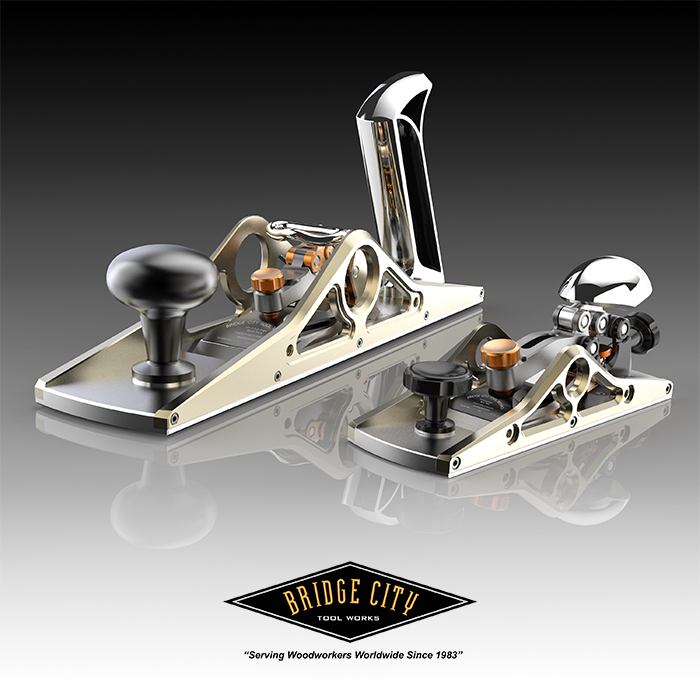
The HP-12 is a multi-purpose plane modeled after the CT-18 Dual Angle Smoother. We only made that plane once, and I am really excited to add this plane to our line of innovative woodworking tools. Here are my thoughts as how this plane design came to be;
BLADE RETENTION MECHANISM
The tradition of wedging an iron to a metal plane bed with a fulcrum lever has remained unchanged for hundreds of years and the reason is simple, it works. However, this constrains the aesthetic possibilities for the plane body. It also makes it difficult to house an iron with dual grinds which is a big deal for me. Because I wanted dual ground irons, I decided traditional blade retention solutions were ripe for exploration. The result is a unique toggle lock system that allows for a dual ground iron and more.
Simply pull the sculpted “D” lever and the entire blade retention mechanism swings out of the way to facilitate iron removal. It is fast, fun, the pressure is adjustable, and you have never seen anything like it. There are no free parts—the mechanism is integrated into the body. Here’s a close up of it open;
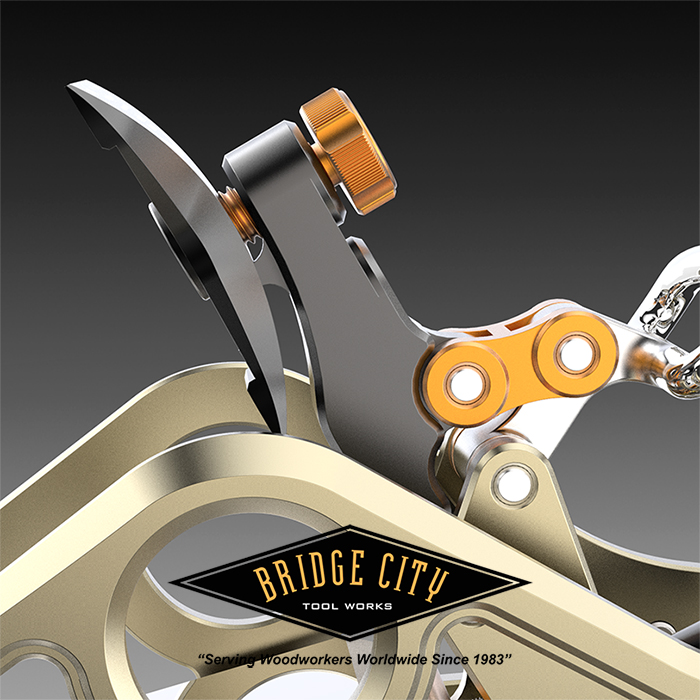
THE TOTES
Both totes of the HP-12 are metal. History suggests these two components (when made from wood) are the first to fail over time, rendering the tool to an uncertain and often unusable fate.
The front tote “mushroom” is turned from aluminum, bead blasted and anodized black. We believe this shape is more hand friendly than the more common “balloon” totes. This tote is threaded into the throat plate allowing for precise adjustment of the mouth.
The rear tote is investment cast 304 stainless steel with the two interior cavities painted black. Shaped to invoke the illusion of movement. The highly polished curved surfaces add a nice reflective contrast to the colors of the plane components. The variable chamfer at the top of the tote ties in nicely with the graceful chamfers of the plane sides. The angle of the tote is perpendicular to the iron edge directing the forward motion of the plane straight at the cutting edge.
Lastly, I tried my best to make this hand friendly, particularly for those of you with bear paws for hands.
THE BODY
The symmetrical HP-12 plane body features an adjustable mouth also made from 304 stainless-steel. The body, twelve inches long (304.8 mm) heel to toe, features a twelve-degree bed, with all profiles CNC milled. The sides are CNC milled from 360 aluminum, anodized. Each side is press-fit to the sole with dowel pins and retained with cap screws.
The blade retention mechanism allows the sides of the plane body to be pierced (or skeletonized). These openings, designed for your fingers, dramatically improve the ability to cant the iron in minute increments while reducing the overall weight of the plane. The result is a distinctive visual appeal unique to Bridge City Tool Works.
THE IRONS
The HP-12 will come with two irons with four unique purposes. The available grinds eliminate the need for multiple planes with attack angles of 42 degrees for low angle work, 47 degrees for standard work, and 60 degrees for woods you like to swear at. Lastly, there is a scrub iron grind. This plane, with these attack angle choices, may be the only smoothing plane you will ever use or need.
The robust irons (0.225”/5.7 mm thick) are a full two inches wide (50.8 mm) and are hardened to Rc 60-62 from A2 tool steel. They are lapped to a mirror finish—no flattening required.
When bedded, the non-business edge is protected with an aluminum blade guard. This guard is mandatory when sharpening to avoid injury. The guard attaches to the iron with rare earth magnets.
In the image below, you can see what the scrub shavings look like when planing with the grain. Do this in an aromatic cedar or softwood and you have instant packing material for turnings, pens or any of your other handmade items…
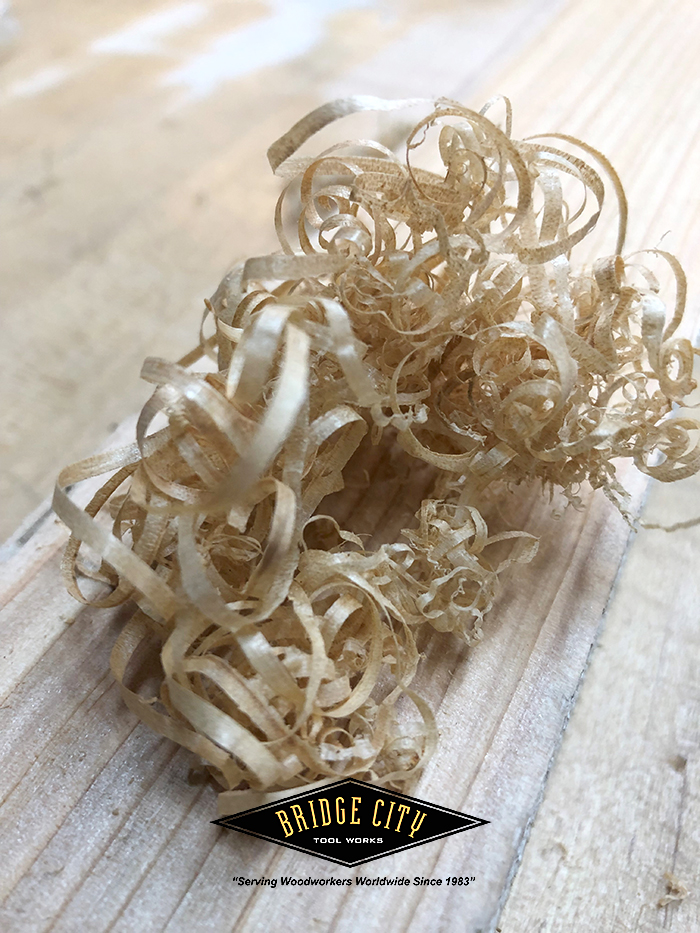
THE IRON DEPTH ADJUSTER
The iron is engaged to the depth adjuster via a pin nut attached to a 0.5mm thread pitch lead screw. One full revolution of the lead screw increases the depth of cut by .1mm (0.004”). The lead screw is housed in a split pivot nut turned from solid brass and the result is a backlash free mechanism that is field adjustable by hand. This mechanism is as smooth as butter in use. Blade canting can be achieved by shifting the lead screw side to side but in practice this is not as preferable, or as fast, as canting with the fingers through the sides of the plane body.
In the image below, you can see the adjuster. Also visible is the brass split nut (this eliminates thread backlash) that is hand adjustable with the two orange screws…
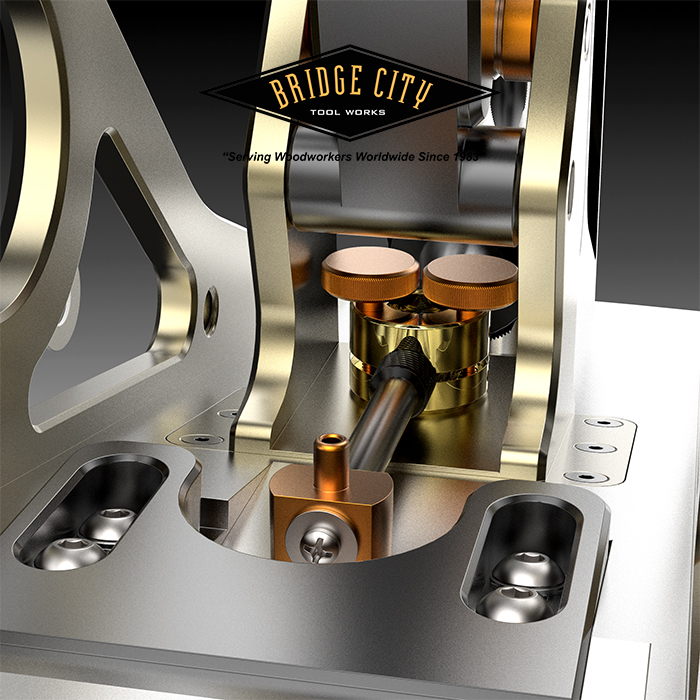
DEPTH SKIDS
The single distinguishing feature of the HP-12 over any other plane made today, is the ability to add depth skids; essentially turning your plane into a 2” thickness planer.
The ability to thickness plane to a precise thickness is an incredible benefit for box makers, for making louvers, models, musical instrument makers, inlay strips… and the list goes on.
To set the skids, you can use shop made shims or, as is our preference, pin gages. It is entirely possible, and easy, to make multiple components with a thickness that does not vary more than 0.002”!
The skids feature rounded soles which not only reduce friction but allow you to set them at different depths for creating tapered stock (louvers). Either straight or tapered, you cut until the plane no longer makes a shaving—it is fun and the accuracy is amazing. No sanding makes it even better. Here is an image of two HP-12 Dual Angle Bench Planes, one with the skids attached…
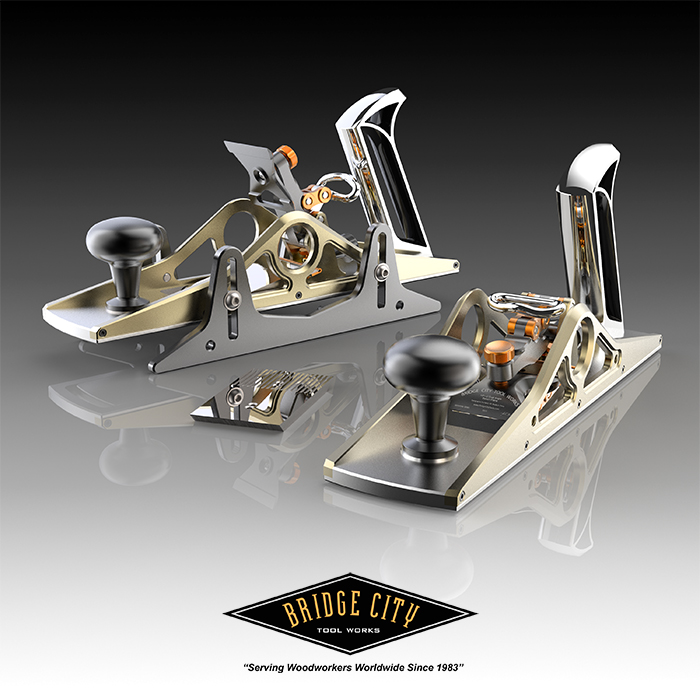
DETAILS
L = 304mm/12”, W = 70mm/2.75” H = 133mm/5.25”
Weight with Depth Skids = 2575 grams (5.67 lbs)
What really excites me is this bench plane may be the only bench plane many woodworkers need in a modern equipped wood shop.
As always your thoughts matter, so if the urge strikes please comment. Despite what my wife and kids say, I do listen.
When I can hear you.
-John

Damn John. You’ve still got it!
Beautiful evolution!
And I thought you were just playing in the back yard with your grandkids!
Neil
Thanks Neil!
Actually, my best work is ahead of me now that I don’t have to manage Consuelo! Or the other way around… 😀
John
Beautiful Design! Thank-you. I’m hoping the depth guage works well for violin sides!
I see no reason why you would not be successful using the HP-9 Dual Angle Block Plane with the skids for violin sides!
John
I really love the retaining flange to stop the blade-retaining cap from rotating. The two thumbscrews on the depth-adjuster split nut are very cool-looking. I’m wondering how often one would ever actually unsplit the split nut? This will be a lot easier with the thumb screws, but is there a possibility of adding something that a casual user might screw up? And along those lines, given that it’s now easier for the casual user to open up the split nut, would it be useful to make it asymmetric (rounded triangle, perhaps), so that the two halves always go back together in the same orientation? With the circular profile, I could imagine getting one of the two halves rotated 180 degrees, and the thread not matching with the adjustment screw. I’ve never taken mine apart, so I have no idea of how big a deal that would be.
By the way, I was using the toothing blade in my CT-?? dual-angle smoother (I can never remember the numbers) this morning to help to flatten a highly figured slab of willow. Wow! I wish I had thought of using that a few weeks ago! I’ve also used the scrub blade for some serious stock removal. This is truly an all-round plane. I think your patrons will be pleased!
Peter,
There is no reason to take apart the split nut. In use, those thumb wheels are for tightening against the lead screw to eliminate the backlash. This is a big issue with a new lead screw as the threads are sharp. They need to cut the brass in order to get a perfect, backlash free mate. Over time, the mating parts will reach a perfect equilibrium for a smooth, backlash free movement.
However, for those with inquisitive minds…. should one ever take apart the split nut, there are indentations on each part so they can be reassembled correctly timed.
As you now know, scrub irons rock!
-John
Hi John,
Any idea when we will be getting our pencil precision kit? It was supposed to be delivered Fall 18.
I was really looking forward to spending some quality time at the shop with the kids.
Thanks
Hamad
CT-18 Peter,
That’s one sweet plane and I have used mine many times as well.
John,
Is the HP-12 similar in size and function to the CT-18 just made in a different material and with some upgraded features?
For the final crazy question, will we just buy these when they come up the the website instead of placing an order? Insanity, I tell ya!
Best,
Rutager
Rutager,
The CT-18 is almost identical in size to the CT-18 but has aluminum sides. It is also now all metric. For sure the function is the same.
Lastly, I don’t know how they are going to offer these. I do believe it might makes sense to do some kind of pre-order to gage the production requirements.
John
Hamad,
I am working with on finding a supplier that will GUARANTEE that the cedar blanks are straight grained. It has been a huge pain, but it is solvable. My hope is to get them delivered by end of year. We will see.
John
John, was watching NYC CNC on you tube
Today’s video was about mirror finish.
I thought you might want to see it.
It was done with a 1/2 end mill
Looking forward to the new tool release’s
have a safe and productive trip Ralph
Ralph,
That was a fascinating video. Thanks for sharing.
Best- John
I grew up on vintage planes and have a great respect and love for them, many of them belonged to my grandfather and great-grandfather. My Dad is even named after Stanley tools. So, I NEVER thought I would like a “modern” plane, but here I am drooling over these tools. A bit outside my price range for now, but they seem well worth it. I love the aesthetic, they are usable and functional pieces of art. Be proud.